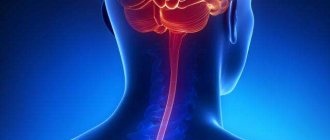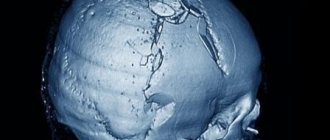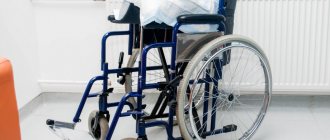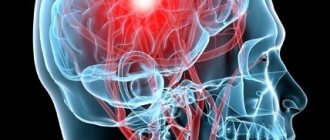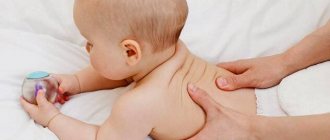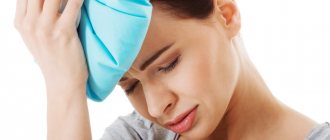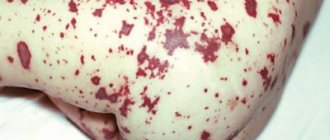Meningitis
- is an infectious-inflammatory process that affects the meninges. The development of the disease is associated with the vital activity of bacteria, protozoa, viruses and fungi that penetrate the body. The disease can be either independent or a complication of another pathological process. However, in all cases it is acute and requires timely treatment. Rehabilitation after meningitis differs in the range of measures, duration and intensity and depends on the severity of the lesion and symptoms.
Get advice from a rehabilitation specialist or make an appointment
+8
Record
Causes of meningitis in children
The main cause of meningitis in adults is infection in the membranes of the brain, the causative agents of which can be:
- viruses – herpetic, mumps;
- bacteria - staphylococci, meningococci, streptococci, Escherichia coli and tuberculosis;
- fungal infections - mycoses, candida.
Pharmacopuncture
Occupational therapy for children
Hirudotherapy
Vojta therapy
Shock wave therapy
Vacuum therapy
Sanatorium-resort treatment of the consequences of meningitis.
For the most complete recovery, it is simply necessary to use rehabilitation measures and further dispensary medical observation of the recovering person. In the absence of life-threatening factors, rehabilitation therapy is started during the early recovery period. Such rehabilitation measures begin to be carried out in an infectious diseases hospital and continue in a sanatorium.
Recovery from serous meningitis requires:
- Special diet;
- Physiological procedures;
- A combination of different restoration methods with the participation of specialists.
Complications
- cognitive disorders: deterioration of memory, quality of intelligence and mathematical abilities;
- headache
- delayed psychomotor and psychospeech development
- behavioral disorders;
- general cerebral symptoms (nausea, vomiting);
- asthenia, depression, apathy;
- confusion;
- epilepsy;
- disturbances in motor activity: loss of coordination, partial or complete loss of control over one or more limbs.
Initial consultation with a rehabilitation specialist
+8
Record
Causes of meningitis
Meningitis can be of infectious or non-infectious origin. The infectious form of the disease develops as a result of the penetration of microorganisms into the body: bacteria, viruses, fungi and parasites. Non-infectious meningitis develops in patients as a result of taking certain medications and the formation of tumors.
In medicine, classification is used according to the type of pathogenic microorganisms. It is important for a modern person to know how to recognize meningitis and what types of disease exist:
- bacterial meningitis is most often caused by streptococci, meningococci, pneumococci and Haemophilus influenzae, which are transmitted by airborne droplets;
- viral meningitis. The most common form of the disease. This type is characterized by the least severity. The causative agents of viral meningitis are enteroviruses;
- fungal meningitis develops as a result of the activity of certain types of fungal microorganisms;
- parasitic meningitis.
The list of therapeutic measures for meningitis is determined by the factors that caused the development of the disease. Thus, when treating bacterial meningitis, antibiotics are prescribed, which are ineffective for viral meningitis. If a person knows how to recognize meningitis, then the likelihood of diagnosing the disease at the initial stage and the effectiveness of therapeutic measures are high.
To determine the causes of meningitis, specialists at the Yusupov Hospital use modern diagnostic equipment. An important advantage of examinations at the Yusupov Hospital is that patients do not need to wait in lines, since appointments with specialists can be made in advance.
Expert opinion
Andrey Igorevich Volkov
Neurologist, Candidate of Medical Sciences
For several years in a row, infectious diseases have been among the causes of the development of pathologies of the nervous system. Meningitis accounts for 30-40% of cases. Modern drugs and high-quality diagnostics do not guarantee the absence of death. Mortality is explained by late seeking of medical help. Doctors associate this with the atypical course of meningitis, when the symptoms are not specific for a long time.
It is not possible to determine meningitis on your own. The clinical picture of the disease is varied. Signs differ according to the etiological factor. The initial symptoms of meningitis are often mistaken for cold symptoms. As the infection spreads, the condition worsens sharply. The high risk of death due to meningitis persists for 1-2 days from the onset of the first pathological symptoms. Delayed diagnosis and therapy lead to the development of severe, life-threatening complications. Therefore, it is important to immediately consult a doctor if you suspect the development of meningitis. At the Yusupov Hospital, the examination takes a minimum amount of time. The treatment plan is determined in accordance with the identified pathogen.
Goals of rehabilitation of children after meningitis
The goal of rehabilitation treatment is to restore lost functions as much as possible and prevent complications. To achieve this goal, we use modern recovery and treatment methods, which we combine depending on the severity of the disease and the characteristics of the child.
Rehabilitation after meningitis includes the following main components:
- Doctors' supervision
. As a rule, the child is observed by a neurologist and a rehabilitation specialist. In case of severe movement disorders and the development of contractures and deformities, an orthopedist is included in the rehabilitation team. - Drug therapy
- Physiotherapy
. We select a physiotherapeutic treatment program individually for each child. - Physical rehabilitation
. Formation and restoration of motor skills. Physical rehabilitation activities include exercise therapy and ergotherapeutic training. - Classes with a neuropsychologist
for disorders of higher nervous functions such as memory, attention, thinking. - Classes with a speech therapist
for speech and swallowing disorders.
Occupational therapy
Bobath therapy
What is the PNF technique?
Manual therapy
Reflexology
Kinesiotherapy
Effective recovery after meningitis is the daily work of the medical team, which improves the quality of life of even severe patients.
Diet
The rehabilitation period after meningitis in children and adults also involves following a specially designed diet. The basis is considered to be fractional meals. Patients should eat at least 5 times a day. All foods should contain a variety of minerals, vitamins and nutrients, which helps strengthen the immune system.
The diet may include the following components:
- Lean boiled meat. Children are given pureed poultry, rabbit or veal.
- Steamed vegetables and fruits.
- Boiled fish.
- Lightly dried bread.
- Chicken eggs, soft-boiled or omelettes.
- Dairy products.
- Compotes, infusions, decoctions, juices, tea, low-fat broths.
You can also eat porridge from various cereals. During the rehabilitation period, you should not eat fried, spicy or too sour foods. Patients may be prescribed vitamin complexes as additional therapy.
Lack of treatment and non-compliance with doctor’s recommendations during the rehabilitation period of meningitis in children and adults causes the development of serious diseases. Most often these are impaired hearing quality, mental retardation, blindness, strabismus and various mental disorders.
Meningitis is a fairly serious and dangerous disease that occurs regardless of age and gender. Like any disease, pathology is easier to prevent than to treat. Experts recommend paying close attention to your health, dressing appropriately for the weather, not getting too cold, carrying out hardening procedures and taking vitamin complexes in the autumn and spring.
- The first signs and symptoms of meningitis
Mild meningitis is easily treatable, but the recovery period can take quite a long time. At this time, it is important to follow all the doctor’s recommendations, since complete recovery can only be achieved with an integrated approach to treatment.
Diagnosis of meningitis
The diagnosis of meningitis can be made based on the results of additional studies - laboratory and instrumental:
- detailed blood test;
- fundus examination;
- X-ray examination of the skull;
- heart electrocardiograms;
- electroencephalography;
- computer and magnetic resonance imaging.
Doctors at the Yusupov Hospital confirm or refute the diagnosis of meningitis using a study of cerebrospinal fluid. A lumbar puncture is performed immediately after examining the patient. Normal cerebrospinal fluid is transparent, colorless, and flows out under a pressure of 130-180 mm during puncture. water Art. It detects from two to eight cells in one microliter. In serous meningitis, the cerebrospinal fluid is colorless, clear or opalescent. During cerebrospinal puncture, it flows out under a pressure of 200-300 mm. water Art. at a speed of 60-90 drops per minute. In the cerebrospinal fluid, from 200 to 800 cells are determined in 1 μl, 80-100% are lymphocytes. The amount of protein and glucose is increased. After the puncture, the patients' condition improves significantly.
With serous-bacterial meningitis, the cerebrospinal fluid may be colorless or yellow, opalescent. During puncture, it flows out in a stream under a pressure of 250-500 mm of water column. The number of cells increases to 800-1000 in 1 μl, they contain the same number of lymphocytes and neutrophils. Protein levels are increased and glucose concentrations are significantly decreased.
The liquor in purulent-bacterial meningitis is cloudy, whitish or greenish-brown. Due to the high viscosity and blockage of the liquor pathways, it often flows out in rare drops under high pressure. The number of cells in one milliliter of cerebrospinal fluid exceeds 1000; they consist mainly of neutrophils. Protein concentration varies from 600 to 16,000 mg/l, glucose levels are reduced.
To confirm the diagnosis of meningitis, doctors use bacteriological examination of mucus from the nasopharynx and cerebrospinal fluid. During bacterioscopic examination of cerebrospinal fluid, smears are stained with Gram or methylene blue. To exclude fungal meningitis, the specimen containing cerebrospinal fluid is stained with ink. Laboratory assistants isolate a pure culture on media with the addition of normal horse serum or cattle serum and identify it by biochemical activity and antigenic structure.
In case of viral meningitis, in preparations prepared with Gram staining and ink, it is impossible to identify the causative agent of the infection. Cultivation of bacteria and fungi also gives negative results. By culturing cellular material with standard laboratory cell lines, a pathogen serologically identical to the measles virus can be isolated. Rubella virus is isolated using the co-cultivation method.
To identify oligoclonal immunoglobulins, the method of agarose gel electrophoresis or isoelectric focusing of cerebrospinal fluid gamma globulins is used. Immunoglobulins appear in a number of viral infections. As a result of immunological studies, viral antigens or antibodies are detected in the cerebrospinal fluid, and the nucleic acid of the virus is detected using the polymerase chain reaction method. The enzyme immunoassay method detects pathogen antigens in feces, urine or saliva. Express methods allow you to quickly and early determine the presence of the herpes simplex virus antigen in the cerebrospinal fluid and blood or the DNA of the virus (using the polymerase chain reaction method).
Laboratory diagnosis of meningitis using modern research methods can be performed at the Yusupov Hospital. According to indications, doctors determine changes in brain tissue using computer or magnetic resonance imaging. If the first signs of meningitis are present, adequate antibiotic therapy is started immediately after diagnosis.
Make an appointment

